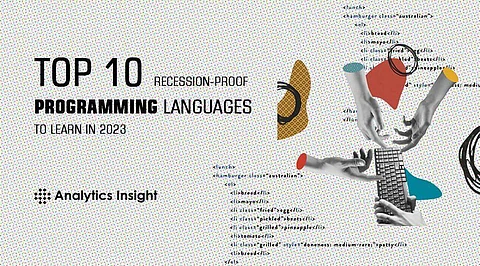
- Insights
- Cryptocurrencies
- Stocks
- White Papers
- Industry
- Geography
- Insights
- Cryptocurrencies
- Stocks
- White Papers
- Industry
- Geography


A programming language is a computer language that is used by programmers (developers) to communicate with computers. For example, in the beginning, the languages were more mechanical and gradually the researchers are coming up with languages that are easier to understand and more user-friendly. However, there are some of the top programming languages to survive the recession in 2023.
The C language was created in 1972. C is a lower-level language that was based on an earlier language called B. It is a general-purpose language, and a parent language which many future programming languages derive from, such as C#, Java, JavaScript, Perl, PHP, and Python. It is used in many applications that must interface with hardware or play with memory.
C++ was developed 11 years later in 1983. It is very similar to C, in fact, it is often considered an extension of C. It added various concepts such as classes, virtual functions, and templates. It is more of an intermediate-level language that can be used lower level or higher level, depending on the application. It is also known for being used in low-latency applications.
Around the same time as C++ was being released to the public. This version was meant to be an object-oriented version of C (there's a lot in a name, clearly). It is used, probably most famously, by Apple. If you are a Mac or iOS user, then your iPhone or Mac applications were most likely developed with Objective-C (until they recently moved over to Swift).
In 1991, the Python programming language was released, though it had been in development in the late '80s. It is a dynamically-typed, object-oriented language that is often used for scripting and web applications. It is usually used with some of its frameworks like Django or Flask on the backend. It is one of the most popular programming languages in use today.
In 1993, Ruby was released. Today, you probably heard of Ruby on Rails, which primarily is used to create the backend of web applications using Ruby. Unlike the many languages derived from C, this language was influenced by older languages such as Perl and Lisp. This language was designed for productive and fun programming. This was done by making the language closer to human needs, rather than machine needs.
Two years later in 1995, Java was developed. This is a high-level language that is derived from C. It is famously known for its use in web applications and as the language to use to develop Android applications and Android OS. It used to be the most popular language a few years ago, but its popularity and usage have definitely decreased.
In the same year as Java was developed, PHP was born. It is an open-source programming language designed for the purpose of creating dynamic websites. It is also used for server-side web development. Its usage is definitely declining, but it is still in use today.
That same year, JavaScript was brought to the world. Its purpose was to be a high-level language that helped with the functionality of a web page. Today, it is sometimes used as a scripting language, as well as being used on the backend of applications with the release of Node.js. It is one of the most popular and widely used programming languages today.
SQL (Structured Query Language) was developed in the early 1970s by Donald D. Chamberlin and Raymond F. Boyce at IBM. SQL was one of the first commercial programming languages to use Edgar F. Codd's relational model for database management. The programming language was created to manipulate and retrieve data stored in IBM's database management system, System R. Since then, the American National Standards Institute (ANSI) and the International Standards Organization (ISO) have deemed the SQL language the standard language in relational database communication.
COBOL, which stands for Common Business Oriented Language, was developed in 1959 by the Conference on Data System Languages (CODASYL). At the time, computer users and manufacturers were concerned about the rising programming cost. It was suggested that if a common business-oriented language were used, the conversion would become cheaper and faster. As a result of these concerns and a meeting with the Department of Defense, COBOL was born and has since been used primarily in business, finance, and administrative systems for companies and governments.
